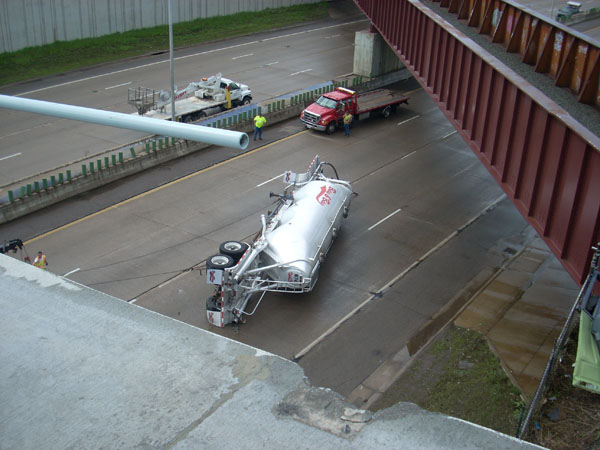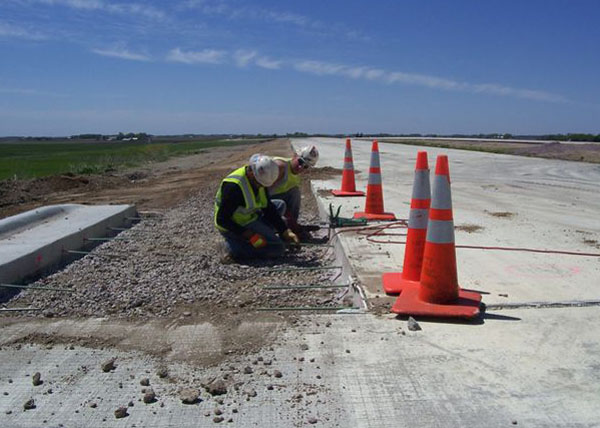 |
|

|
 |
TABLE of CONTENTS
 |
Strong storms move through Minneapolis; blow semitrailer off bridge |
|
By Lisa Yang

Crews work to clear a semitrailer from westbound Interstate 94 in Minneapolis after a strong storm lifted it from the Camden Avenue bridge and blew it over a four-foot concrete barrier wall. Photo by Mike Anderson
|
A semitrailer parked on the Camden Avenue bridge in Minneapolis was lifted by a strong storm and blown over a four-foot concrete barrier wall, taking out two 20-foot sections of steel-barrier railing on the sidewalk before landing on the westbound lanes of Interstate 94.
The storm, which spawned a tornado, moved through the north end of Minneapolis and surrounding suburbs May 22, leaving hundreds of trees uprooted and several structures damaged.
MnDOT’s Bridge crews already were working in the area and arrived at the bridge scene shortly after the incident. Crew members helped place traffic control devices on the bridge and surrounding areas. They repaired the steel-barrier railing, took down a damaged railroad bridge sign, cleaned up road debris and kept onlookers away from fallen power lines.
Four MnDOT Bridge crews were involved at the scene:
- Spring Lake Park
- Forest Lake
- Mendota
- Eden Prairie
“Everyone stepped up to the plate to take whatever action was necessary to complete the tasks we had to do,” said Bruce Andersen, Spring Lake Park Bridge crew supervisor. “This whole operation was completed using the skills and knowledge of everybody who was there to help.”
Metro District is currently lending equipment to the city of Minneapolis to assist in their recovery efforts. |
 |
|

|
 |
TABLE of CONTENTS
 |
Report recognizes Minnesota for measuring performance of transportation dollars |
Minnesota is one of five states leading the way using data to guide and prioritize transportation investments, according to a recent report released by the Pew Center on the States and the Rockefeller Foundation. The other top states are Maryland, Missouri, Oregon and Virginia.
The report, Measuring Transportation Investments: The Road to Results, found considerable differences among the 50 states and the District of Columbia in linking transportation systems to six key goals important to states’ economic well-being and taxpayers’ quality of life—safety, jobs and commerce, mobility, access, environmental stewardship and infrastructure preservation.
In all six categories, Minnesota was found to be “leading the way,” the highest rating given by the Pew-Rockefeller study.
“We’re pleased to learn that we’re among the top in the nation in tracking the performance of our transportation system because it’s a key part of our business practices and helps guide tough investment decisions in this era of tight budgets,” said Commissioner Tom Sorel.
The report cites MnDOT’s use of performance measures for 10 policy areas identified in its 2009-2028 Statewide Transportation Policy Plan. These measures include adjusting to the transportation needs of a growing and aging population as well as enhancing mobility by reducing congestion on nine percent of the highway system that carries about half of the state’s roadway travel.
To view the full report and fact sheets for each state, visit www.pewcenteronthestates.org/transportation. To view the Minnesota Statewide Transportation Policy Plan, visit www.dot.state.mn.us/planning/stateplan/index.html. |
 |
|

|
 |
TABLE of CONTENTS
 |
Third stage of Hwy 14 corridor project begins |

Crews install rebar to tie on the shoulder of Hwy 14 in Waseca as part of the Waseca bypass project.
The $56.2 million project will improve traffic safety and mobility over the interregional corridor that connects New Ulm, Mankato, Waseca, Owatonna and Rochester. Work scheduled for this year includes:
- Four-lane expansion of Hwy 14 with south bypass of Waseca
- 10 miles of new four-lane highway
- 10 new bridges
The project is expected to be completed by summer 2012, with a small section opening mid-summer 2011—west edge of Waseca to Hwy 13.
For more information, visit www.dot.state.mn.us/d7/projects/14owatonna/#stagec\. Photo by Rebecca Arndt |
|
 |
|

|
 |
TABLE of CONTENTS
 |
Zipper merge campaign aims to reduce congestion, crashes in work zones |
By Chris Krueger

Zipper merge campaign logo |
Motorists will receive tips on how to merge in construction zones this summer through a public education campaign sponsored by MnDOT.
The “Do the Zipper Merge” education campaign, combined with additional stationary and portable construction signs, is designed to increase awareness of the zipper merge as the correct behavior in traffic that is congested due to roadwork. The campaign will consist of outdoor billboards, radio and television spots, a brief instructional video and a website that provides motorists with detailed information. The campaign will run from May 16 to June 30.
“Raising awareness for motorists to use the zipper merge in construction zones will help reduce crashes, speeds and congestion,” said Sue Groth, Office of Traffic, Safety and Technology director.
Most Minnesota motorists start to merge in construction zones as soon as they see warning signs and learn which lane ahead is closed, according to Groth. This driving behavior can lead to dangerous lane switching, long back-ups that sometimes block interchanges and other accesses, inconsistent driving speeds that cause crashes and road rage.
The zipper merge benefits individual drivers by:
- Reducing differences in speeds between two lanes
- Reducing the overall length of traffic backup—as much as 40 percent
- Reducing congestion on freeway interchanges
- Creating a sense of fairness and equity that all lanes are moving at the same rate
- Reducing incidents of road rage
Results from MnDOT’s Online Customer Community survey indicate that the greatest barrier for motorists to adopt the zipper merge behavior is Minnesotans’ cultural mindset or attitude that labels motorists who use the zipper merge as rude or not “Minnesota nice.”
“We are on a mission to tell Minnesota drivers that this approach is acceptable,” Groth said. “They can consider it Minnesota nicer.”
For more information on the zipper merge, visit www.dothezippermerge.com. |
 |
|

|
 |
TABLE of CONTENTS
 |
Minnesota retains ranking as fourth best state for bicycling |
By Jessica Wiens
Minnesota remains at the fourth spot in the League of American Bicyclists’ annual bicycle friendly state rankings, but has moved up to receive a silver-level designation. Minnesota was given a bronze-level designation in 2009.
The rankings and awards are published every May during National Bike Month to further encourage states to improve their bike-friendliness.
“Achieving this designation is an honor for all bicycle advocates across the state that have spent the last several years improving conditions and safety for commuter and recreational bikers,” said Commissioner Tom Sorel.
Many MnDOT employees are choosing to ride their bikes to work more often.
“The relationship between motorists and cyclists has improved immensely in the 30 years I’ve been commuting by bicycle,” said Mike Schadauer, Transit Office director. “The most frequent misconception I notice is that some motorists do not acknowledge a cyclist’s right to use a whole lane when obstacles require it, but that seems rarer all the time.”
There are eight rules of the road to improve bicycle safety:
- Bicyclists may ride on all Minnesota roads, except where restricted — such as interstates.
- Bicyclists should ride on the road and must ride in the same direction as traffic.
- Motorists must maintain a three-foot clearance at all times when passing a bicyclist.
- Bicyclists must obey all traffic control signs and signals, just as motorists.
- Motorists and bicyclists must yield the right of way to each other.
- Bicyclists must signal their turns and should ride in a predictable manner.
- Bicyclists must use a headlight and rear reflectors when it is dark.
- Bicyclists should always wear helmets and bright reflective gear.
“We all deserve to get to work safely, no matter what mode we use,” Sorel said. “Thank you to all MnDOT employees who consciously make everyone’s safety a priority during their commute.”
Upcoming Bike Walk Week activities
The Twin Cities Metro area is hosting its Bike Walk Week events June 4-12, with Bike/Walk to Work Day on June 9.
For a complete list of Bike Walk Week events in Greater Minnesota and the Twin Cities Metro area, visit www.bikewalkweek.org. To register for the Commuter Challenge and pledge to use the bus, train, bike, carpool, walk, telework or vanpool at least one day before June 30, visit www.mycommuterchallenge.org. |
|
 |
|

|
 |
TABLE of CONTENTS
 |
Ombudsman’s Office releases 2010 Annual Report |

Mn/DOT Ombudsman’s Office—(front row from left) Darlene Lazer, current executive assistant; Sophia Yang, former executive assistant; Christine Thomas, student worker; (back row from left) Chris Moates, assistant to the ombudsman; Marcell Walker, assistant to the ombudsman; Deb Ledvina, ombudsman; (not pictured) Sean Skibbie, student worker. Photo by David Gonzalez |
The Ombudsman’s Office recently released its 2010 Annual Report, a comprehensive document that highlights contacts and complaints from the public and how they were resolved, identifies trends for improvements and establishes goals for the ombudsman program in 2011.
The ombudsman serves both the public and MnDOT by providing a neutral, informal and independent resource to help decide conflicts when other processes are unable to reach resolution.
“Our office handled 117 contacts in 2010 from individuals, citizen groups, and business owners with a wide range of issues,” said Deb Ledvina, transportation ombudsman.
Since its inception in October 2008, the ombudsman has handled more than 250 public contacts.
“In 2011, the ombudsman will continue to serve as a resource for the public to help resolve issues with MnDOT through development of the existing program and growth in areas of conflict management and conflict resolution,” said Commissioner Tom Sorel.
Some of the goals of the office in 2011 include:
- Continuing to build legislative relations and meet with MnDOT partners to enhance awareness and increase understanding of the ombudsman program
- Developing an internal ombudsman program to handle issues raised by employees
- Developing a conflict prediction model to assist project managers and the agency as a whole to identify, predict and reduce or eliminate conflict and costly delays, as well as improve project delivery
- Developing a Center of Excellence in Conflict Management and Consensus as a model for research, training and application, with a focus on negotiation, mediation and conflict management
- Developing and implementing an “Ombud On-Call” program in the districts to improve fact-finding of issues presented to the ombudsman
For more information on the 2010 Ombudsman Annual Report, contact Deb Ledvina at 651-366-3052. |
 |
|

|
 |
TABLE of CONTENTS
 |
Emma Corrie becomes new Operations Division business manager |
By Bob Filipczak

Emma Corrie, Operations Division business manager. Mn/DOT file photo |
Emma Corrie has been named MnDOT’s new Operations Division business manager.
Corrie, who has a master’s degree in Business, brings more than 18 years of human resources experience to the position. Most recently, Corrie served as project manager for the department’s Disadvantaged Business Enterprise and Workforce Collaborative, where her job included engaging various stakeholder groups with competing interests around a common mission—increasing diverse workforce and small business participation on MnDOT projects.
Corrie’s work with the collaborative put her in meetings with unions, community training organizations, disadvantaged businesses, contractors, transportation partners and legislators.
“When you put all those people in a meeting together, it’s about having those tough conversations—and it’s when we skirt the tough conversations, that we tiptoe around the issue and never get it solved,” Corrie said.
The Summit Academy/Local 49 training partnership and MnDOT’s Interstate 694/Hwy 10/Snelling Avenue pilot project concept are some of the solutions that came out of those difficult meetings.
In her new role, Corrie will be responsible for the management of fiscal, administrative, human resources and information resources for the Operations Division.
One of her first steps will be to learn more about the Operations Division and its core business. Corrie said she intends to visit the districts and do a lot of listening.
“I want to learn about their opportunities and challenges; what’s important to them and how I can support their work with division directors at the department level,” Corrie said.
“MnDOT is a great place to work, each district and office is unique—I have worked with several of our district staff and have great respect for their work and commitment to MnDOT,” she said. “I look forward to learning and serving the Operations Division with integrity in the journey ahead.” |
 |
|

|
 |
TABLE of CONTENTS
 |
Online course teaches employees about social media |
The department released a new e-learning program this week that teaches employees about social media—how it works and how to use it at work.
Social media became available to all employees last January on the condition that all employees take a mandatory course to ensure they understand and follow appropriate online conduct and security measures.
Employees can access the e-learning program through the Training Center by searching for course code ADMN00108 or course name Social Media at Work.
Several employees have already taken the course, which will be available through Aug. 31. |
 |
|

|
 |
TABLE of CONTENTS
 |
Work continues on new Rochester maintenance facility |
By Justin Capelle, District 6 Public Affairs

Work is progressing on the new District 6-Rochester maintenance facility, which is expected to be completed in November 2012. Photo by Justin Capelle |
Dirt is turning outside the District 6-Rochester headquarters as crews prepare the site for a new maintenance facility that will add approximately 122,000 square feet of roof space.
The facility will assist maintenance operations for the Rochester area and will be the maintenance support headquarters for all of southeastern Minnesota.
The project, expected to be completed in November 2012, began in 2008 when the Legislature appropriated $1.5 million to develop plans. The project jump-started in 2010 when the MnDOT Capital Request was approved for $23.43 million.
The new maintenance facility will include:
- Equipment repair center and service bay
- Warm storage garage that will prolong the life of equipment
- Sections for bridge, highway, building and sign maintenance
- Inventory storage
- Cold storage buildings
- Storage for brine, sand and salt
- Yard bins and a fueling station
- New administrative offices
“The maintenance facility will allow the District 6 headquarters to be a more efficient work station,” said Steve Wondrasch, District 6 physical plant supervisor and project manager.
In addition, the facility will be eco-friendly thanks in large part to a meticulous planning process.
“Careful planning will allow us to preserve wetlands in the area and treat storm runoff,” Wondrasch said. “The structures themselves will use geothermal heating and cooling sources, and natural day lighting.”
No soil will be permanently removed from the site during construction and District 6 is working to reduce energy use by 30 percent.
“In the beginning, our goal was to divert 50 percent of our construction and landfill material, and I know we have diverted more than 50 percent.” Wondrasch said.
This means crews are reusing and recycling most of the demolition waste and packaging material.
Pending current construction of the maintenance facility, MnDOT will request $13.8 million in the 2012 capital budget to be used for renovating the existing headquarters.
Employees can view project progress by visiting oxblue.com/pro/open/knutson/mndot or
ihub/d6/new-building/index.html. |
 |
|

|
 |
TABLE of CONTENTS
 |
View beneath the helmet: a bicyclist’s daily commute |
By Bonnie McCabe, Office of Land Management

Bonnie McCabe, Office of Land Management |
Now is the time when bicyclists and motorists get reacquainted after a long, slippery winter. May also is National Bike Month.
I started biking to work in 2009. At first it was only one or two days per week, often on Fridays when it was easier to pack my casual clothes. Last year, I started again in March and then biked almost every day April through October, unless I needed a car.
I live about seven miles from work and telecommute one day per week, which leaves four days to bike. Biking is a great source of transportation for me. It gives me more energy, uses less gas and leaves an extra vehicle at home for other family members to use. The real benefit is that I’m forced to bike home at the end of the day when I don’t think I have much energy. Once I get going, I’m grateful for the ride.
Thankfully, my route is mostly on a bike path or a bike lane. Only about a half-mile is on a lousy, busy street. I always enter that street between vehicle clusters to avoid traffic around me. I also frequently check over my shoulder.
One frustrating component is that some people are still confused if bicyclists operate as a vehicle or a pedestrian. Bikes are recognized as legal vehicles.
When I’m in a vehicle and near a bicyclist, I try to leave enough room for any biking or driving “mistakes,” including bicyclists who do not think the rules of the road apply to them or other inattentive motorists. Compared to the motorists next to them, bicyclists are quite vulnerable to getting hurt if something goes wrong.
Outside work, I try to use my bike in the summer months to run errands. I usually take a vehicle when my purchases are too awkward or big to carry.
Since I became a bike commuter a couple summers ago, it has been amazing how many MnDOT folks are curious about the logistics of biking to work. They just need that bit of encouragement to try it once. |
 |
|
| |
|



